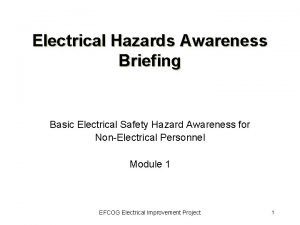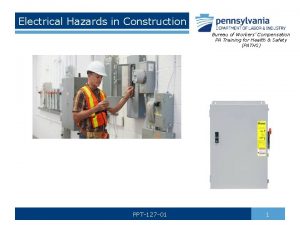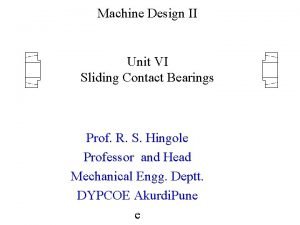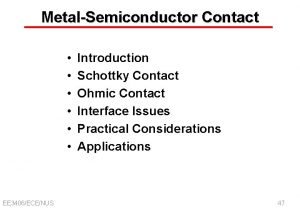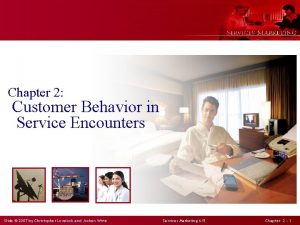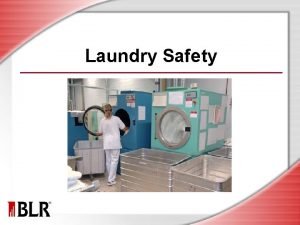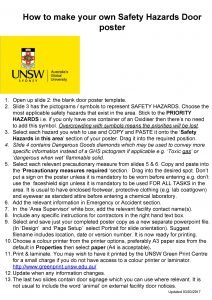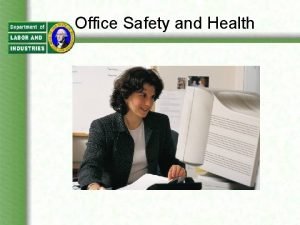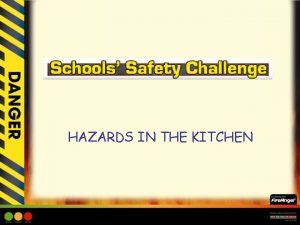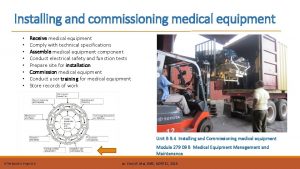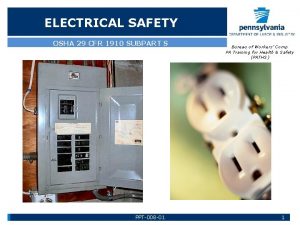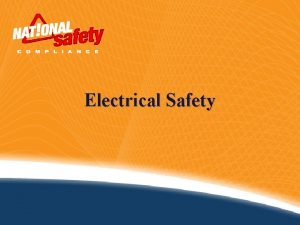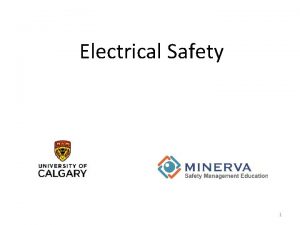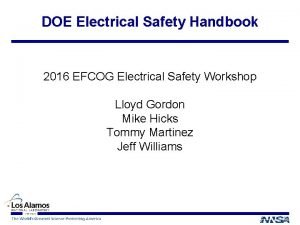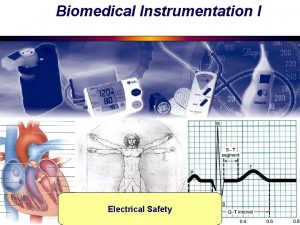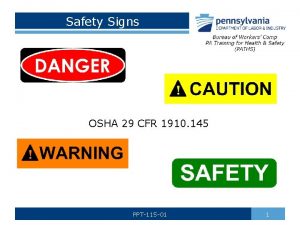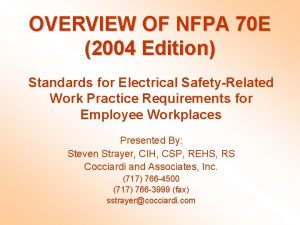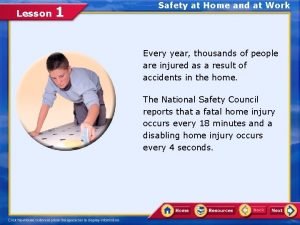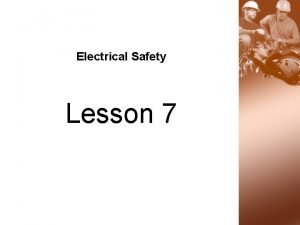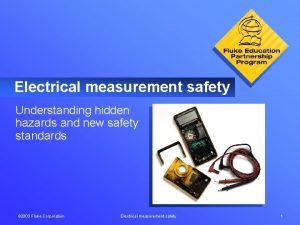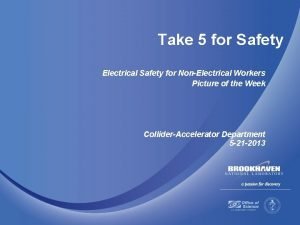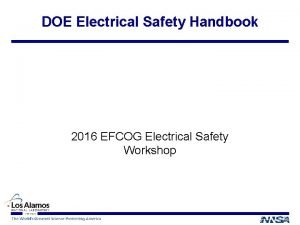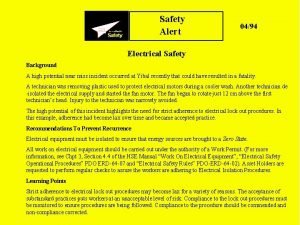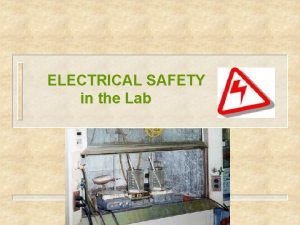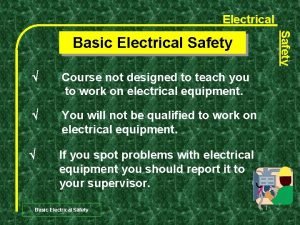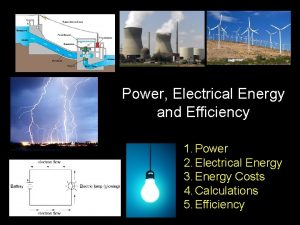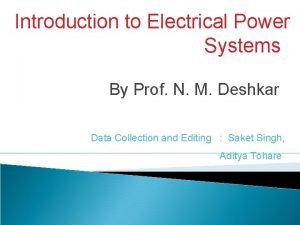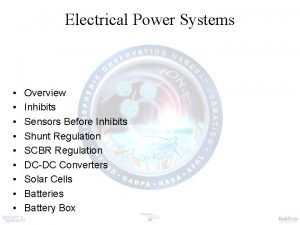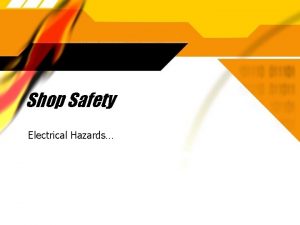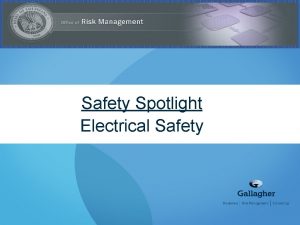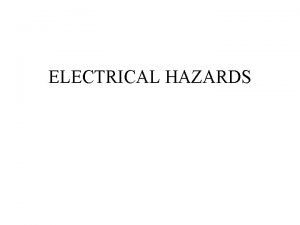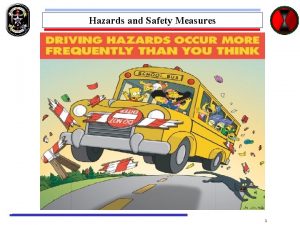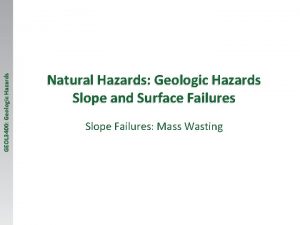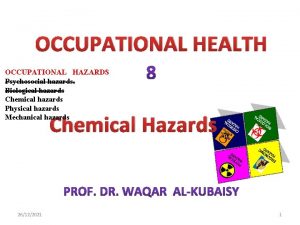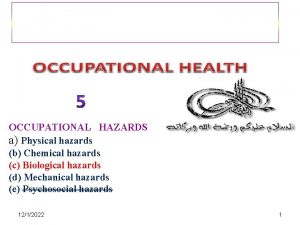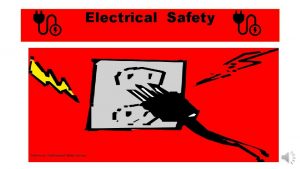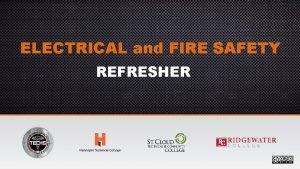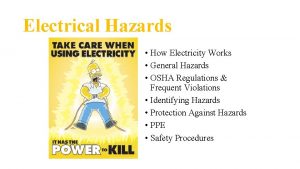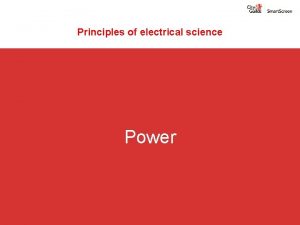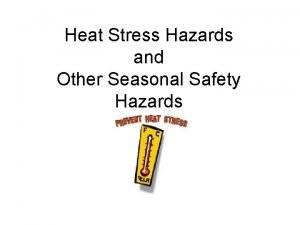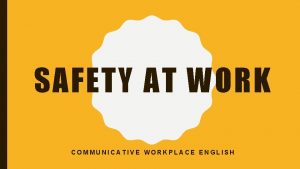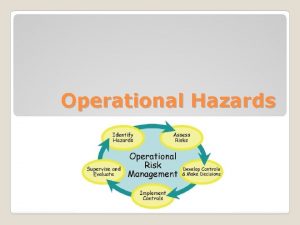ELECTRICAL HAZARDS ELECTRICAL SAFETY u Contact with Power













































- Slides: 45

ELECTRICAL HAZARDS

ELECTRICAL SAFETY u Contact with Power Lines u Lack of Ground Fault Protection (GFCI) u Improper Grounding u Improper Use of Equipment u Improper Use of Cords

Contact with Power Lines

EXAMPLES OF EQUIPMENT THAT CAN CONTACT POWER LINES u u u u u Aluminum Paint Rollers Backhoes Concrete Pumpers Cranes Long-handled Cement Finishing Floats Metal Building Materials Metal Ladders Raised Dump Truck Beds Scaffolds

HOW DO I AVOID HAZARDS? u Look for Overhead Power Lines u Look for Buried Power Line Indicators u Maintain 10’ Distance From ALL Energized Overhead Power Lines u Assume That Overhead Lines Are Energized u De-energize and Ground Lines When Working Near Them u Use Non-conductive Ladders

MAINTAIN 10 FOOT DISTANCE

Lack of Ground. Fault Protection

HOW DO I AVOID HAZARDS? u u Use Ground-fault Circuit Interrupters (GFCIs) Test GFCIs Use Double-insulated Tools Use Tools and Equipment According to the Instructions u Visually Inspect All Electrical Equipment Before Use

TESTING A GFCI

GFCI IN SERIES

Improper Grounding

HOW DO I AVOID HAZARDS? u Ground All Power Supply Systems, Electrical Circuits, and Electrical Equipment. u Frequently Inspect Electrical Systems u Visually Inspect All Electrical Equipment Before Use u Use Equipment With Three-wire Cord With Ground (and Be Grounded) or Use Double-insulated Tools u DO NOT Remove Ground Prongs/Pins

GROUND PIN MISSING

GROUND PIN BEING CUT

GROUNDING NOT CONTINUOUS

DAMAGED 3 PRONG PLUG

PROPERLY GROUNDED CORD

DOUBLE INSULATED SYMBOL

LIFE AND DEATH IN THE FIELD. . . u An HVAC worker was installing duct work using a double-insulated drill connected to a drop light cord. Power was supplied through two extension cords (home-made cord and a UL-approved cord) from a nearby residence. The individual's perspirationsoaked clothing contacted bare exposed conductors on one of the cords, causing an electrocution.

Improper Use of Equipment

Common Examples of Improper Use of Equipment u u u u Using Multi-receptacle Boxes Designed to Be Mounted by Fitting Them With a Power Cord and Placing Them on the Floor Fabricating Extension Cords With ROMEX® Wire Using Equipment Outdoors That Is Labeled for Use Only in Dry, Indoor Locations Attaching Ungrounded, Two-prong Adapter Plugs to Threeprong Cords and Tools Using Circuit Breakers or Fuses With the Wrong Rating for Over-current Protection Using Modified Cords or Tools Using Cords or Tools With Worn Insulation or Exposed Wires

HOW DO I AVOID HAZARDS? u Use only equipment that is approved to meet OSHA standards u Use all equipment according to the manufacturer's instructions u Remove Damaged Tools From Service u Do not modify cords or use them incorrectly u Be sure equipment that has been shop fabricated or altered is in compliance


IMPROPER USE OF ELECTRICAL OUTLET BOX

GENERAL CONTRACTOR OR ELECTRIAN? ?

DAMAGED CORD

FRAYED WIRING

u Improper Use of Cords

HOW DO I AVOID HAZARDS? u Use Factory-assembled Cord Sets u Use Only 3 -wire Extension Cords u Use Only Hard or Junior-Hard Usage Extension Cords – ST, SO, STO, SJT, SJO, SJTO u Protect Cords Running Through Doors, Window, Floor Openings u Remove Cords From Receptacles by Pulling on the Plugs, Not the Cords

ACCEPTABLE EXTENSION CORDS

HOW DO I AVOID HAZARDS? u Inspect Cords Before Each Use u DO NOT Use Worn or Frayed Cords u DO NOT Fasten With Staples or Nails

CORDS IMPROPERLY WIRED

FRAYED CORD

REMOVE DAMAGED CORD FROM SERVICE

PROVIDE STRAIN RELIEF

COULD BE DAMAGED BY HEAVY EQUIPMENT

STRING LIGHTNING

WHERE DOES IT SAY I CAN’T USE FLAT CORDS? u Cords Must Be Rated As Hard or Junior-Hard Use u FLAT Cords Usually Do Not Have This Rating (If They Do They Can Be Used) u Homemade ROMEX Cords DO NOT Have This Rating

WET CONDITIONS u When a cord connector is wet, electric current can leak to the equipment grounding conductor, and to humans who pick up that connector if they provide a path to ground. Such leakage can occur not just on the face of the connector, but at any wetted portion. Limit exposure of connectors and tools to excessive moisture by using watertight or sealable connectors.


EXTENSION CORD LAYING IN WATER

LOCKOUT/TAGOUT u De-energize Equipment or Circuits u Attach Tags at Points Where Equipment or Circuits Can Be Energized u Identify Tags u Never Remove a Lock/Tag Applied by Someone Else

INADEQUATE PROTECTION

TRAINING u General • In the Avoidance of Hazards • Equipment Operators Must Have Training and Experience u Ground-Fault Protection • Competent Person to Implement the Program

QUESTIONS ?
 Electrical hazards examples
Electrical hazards examples Electrical hazards in construction
Electrical hazards in construction Contact and non contact force examples
Contact and non contact force examples Friction unit
Friction unit What is non contact force
What is non contact force Non-contact forces portfolio
Non-contact forces portfolio Irritant vs contact dermatitis
Irritant vs contact dermatitis Air resistance contact or noncontact
Air resistance contact or noncontact Dangling bond in fullerene
Dangling bond in fullerene Service marketing chapter 2
Service marketing chapter 2 Contact vs noncontact forces
Contact vs noncontact forces Air resistance contact force
Air resistance contact force Laundry hazards
Laundry hazards Door safety hazards
Door safety hazards Office safety hazards
Office safety hazards Safety kitchen hazards picture
Safety kitchen hazards picture Power triangle formula
Power triangle formula Electrical safety analyzer
Electrical safety analyzer Osha 1910 subpart s
Osha 1910 subpart s How electricity works
How electricity works Electrical safety introduction
Electrical safety introduction Doe electrical safety handbook
Doe electrical safety handbook Chassis leakage current
Chassis leakage current Three elements of electricity
Three elements of electricity Electrical safety case study
Electrical safety case study Osha safety signs and symbols
Osha safety signs and symbols Nfpa 70e 2004 standard for electrical safety
Nfpa 70e 2004 standard for electrical safety Lesson 1: electrical safety culture
Lesson 1: electrical safety culture Lesson 7 electrical safety
Lesson 7 electrical safety Fluke electrical measurement safety
Fluke electrical measurement safety Lesson 1: electrical safety culture
Lesson 1: electrical safety culture Take 5 electrical safety
Take 5 electrical safety Doe electrical safety handbook
Doe electrical safety handbook Electrical safety alert
Electrical safety alert Electrical lab safety
Electrical lab safety Basic electrical safety
Basic electrical safety üdc
üdc How to calculate electrical power
How to calculate electrical power Introduction to electrical power systems
Introduction to electrical power systems Electrical power
Electrical power Electrical energy
Electrical energy Safety contour safety depth
Safety contour safety depth Safety care certification
Safety care certification Personal safety vs process safety
Personal safety vs process safety Ind safety report
Ind safety report Basic safety orientation
Basic safety orientation
